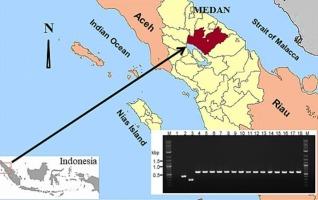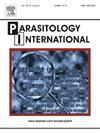A new focus of Taenia asiatica taeniasis in North Sumatra, Indonesia: Molecular confirmation and prevalence
IF 1.5
4区 医学
Q3 PARASITOLOGY
引用次数: 0
Abstract
In the Samosir Island of North Sumatra, Indonesia, the prevalence of taeniasis caused by Taenia asiatica was reported as 2.2 %–20.7 % during 1972–2005. In 2014, another T. asiatica-endemic area was confirmed in the Silau Kahean sub-district of Simalungun District, which is geographically distant from Samosir Island. This study was conducted in the Raya Kahean sub-district of Simalungun District adjacent to the Silau Kahean sub-district in September 2023. The aim was to identify a new T. asiatica-endemic area based on molecular confirmation in addition to determining the prevalence of taeniasis. Men aged ≥18 years and palm plantation male farmers showed a higher prevalence of taeniasis, with an overall prevalence of 21.7 % (93/428). A total of 14 proglottids obtained from 14 tapeworm carriers were identified as T. asiatica by COX1-multiplex PCR analysis, and a new T. asiatica-endemic area was detected in the Raya Kahean sub-district. Genetic analyses of COX1 and pold revealed that T. asiatica from North Sumatra has a poor genetic diversity and is a descendant of the hybrids of T. asiatica and T. saginata. Infections were associated with a habitual consumption of raw pig and wild boar livers. Basic sanitary education, improvement of traditional food habits, and implementation of sentinel surveillance and treatment for tapeworm carriers in endemic areas are required to prevent and control this parasitic disease.

印度尼西亚北苏门答腊的亚洲疟原虫新病灶:分子确认和流行率。
据报道,1972-2005年间,印度尼西亚北苏门答腊的萨莫西尔岛由亚洲奚蚊引起的奚蚊病发病率为2.2%-20.7%。2014 年,在与萨莫西尔岛地理位置相距较远的西马伦贡区 Silau Kahean 分区确认了另一个亚洲弓形虫流行区。这项研究于 2023 年 9 月在毗邻 Silau Kahean 分区的西马伦贡区 Raya Kahean 分区进行。目的是根据分子确认确定一个新的亚洲锥虫病流行区,同时确定锥虫病的流行率。年龄大于 18 岁的男性和棕榈种植园男农民的尾丝虫病发病率较高,总体发病率为 21.7%(93/428)。通过 COX1-多重 PCR 分析,从 14 名绦虫携带者身上获得的 14 个原虫被鉴定为 T. asiatica,并在 Raya Kahean 分区发现了一个新的 T. asiatica 流行区。COX1 和 pold 的遗传分析表明,北苏门答腊的 T. asiatica 遗传多样性较差,是 T. asiatica 和 T. saginata 杂交种的后代。感染与习惯性食用生猪和野猪肝脏有关。要预防和控制这种寄生虫病,就必须开展基本的卫生教育,改善传统的饮食习惯,并在绦虫流行地区对绦虫携带者实施定点监测和治疗。
本文章由计算机程序翻译,如有差异,请以英文原文为准。
求助全文
约1分钟内获得全文
求助全文
来源期刊

Parasitology International
医学-寄生虫学
CiteScore
4.00
自引率
10.50%
发文量
140
审稿时长
61 days
期刊介绍:
Parasitology International provides a medium for rapid, carefully reviewed publications in the field of human and animal parasitology. Original papers, rapid communications, and original case reports from all geographical areas and covering all parasitological disciplines, including structure, immunology, cell biology, biochemistry, molecular biology, and systematics, may be submitted. Reviews on recent developments are invited regularly, but suggestions in this respect are welcome. Letters to the Editor commenting on any aspect of the Journal are also welcome.
 求助内容:
求助内容: 应助结果提醒方式:
应助结果提醒方式:


